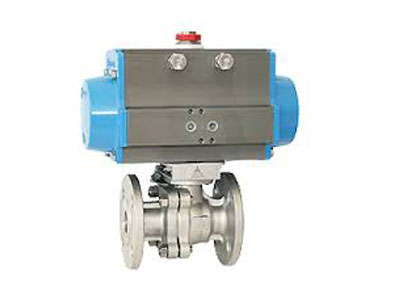What Is Pilot Valve In Pneumatic?
Key Takeaway
A pilot valve in pneumatic systems is a small valve that controls the flow of fluid to a larger valve. This larger valve, known as the main or piloted valve, typically manages high pressure or large volumes of compressed air, liquids, or gas. The pilot valve operates by directing a limited flow of fluid, which then activates the main valve.
Pilot valves are commonly used because they allow for remote and efficient control of the main valve. They work by using the external flow of fluid to control the opening and closing of the main valve, instead of manual switches. This type of valve is useful in environments where direct electrical control might be hazardous, such as in wet or explosive conditions. Pilot valves can be single or dual pilot-controlled and come in various configurations, including poppet and spool types.
Understanding the Role of Pilot Valves in Pneumatic Systems
Pilot valves are often referred to as control valves because they direct the operation of main valves in a pneumatic system. These valves operate by using air pressure or a mechanical actuator to control larger valve systems. When a pilot valve is actuated, it either opens or closes the main valve, triggering the flow of compressed air throughout the system.
Pilot valves typically use a smaller volume of air compared to the main valves they control. This makes them energy-efficient and ideal for systems requiring precision, such as in automated production lines and robotics. By controlling the main valve’s operation, the pilot valve ensures that the system works as intended, directing airflow to the right components at the right time.

Structure and Working Principle of Pilot Valves
Pilot valves have a simple yet effective structure, typically consisting of a small valve body with ports for air input, exhaust, and output. The key components include:
1. Control Port: Where the air pressure is applied to activate the valve.
2. Pilot Actuator: The mechanism that responds to the pressure, moving the valve into one of its positions.
3. Exhaust Port: Where air is released when the valve changes positions.
The working principle involves air pressure being applied to the control port, which moves the actuator. This motion either opens or closes the valve, depending on the system requirements. Because the pilot valve operates with minimal air consumption, it is an efficient and effective way to control pneumatic systems.
Applications and Benefits of Pilot Valves
Pilot valves are commonly used in systems where precise control of airflow is necessary. Some notable applications include:
Robotic Systems: Pilot valves control the movement of robotic arms by activating the main valve that supplies air to the cylinders.
Industrial Automation: In automated assembly lines, pilot valves are used to control the sequence of actions, ensuring that machines operate smoothly and efficiently.
Pneumatic Tools: Pilot valves help regulate the airflow to pneumatic tools, optimizing their performance and preventing unnecessary air wastage.
Benefits:
Energy Efficiency: Since pilot valves use less air to control larger valves, they help conserve energy and reduce operational costs.
Precision Control: They allow for highly accurate control of airflow, ensuring that pneumatic systems operate at peak efficiency.
Reduced Wear and Tear: By controlling the larger valves more effectively, pilot valves help minimize stress on other components, extending the lifespan of the system.
Differences Between Pilot Valves and Other Pneumatic Valves
While pilot valves serve a specific function in controlling the operation of larger valves, there are key differences between them and other types of pneumatic valves:
Size and Function: Pilot valves are typically smaller than standard pneumatic valves, as they are designed to control other valves rather than regulate airflow directly.
Actuation: Pilot valves are often actuated by air pressure, while other valves, like 3/2 or 5/2 valves, can be manually or electrically actuated.
Control Type: Pilot valves control the operation of a main valve, whereas standard valves control the airflow directly to cylinders or tools.
These differences make pilot valves ideal for precise control and automation, while other valves might be better suited for direct airflow regulation or higher pressure applications.
Common Issues and Maintenance of Pilot Valves
While pilot valves are generally reliable, they can experience issues over time that may affect system performance. Common problems include:
Air Leaks: Leaks around the valve can reduce efficiency and cause performance issues. Regular inspection of seals and gaskets can prevent this.
Sticky Operation: If the pilot valve becomes sticky or unresponsive, it may be due to dirt or debris buildup. Cleaning and lubrication can often resolve this issue.
Valve Sticking or Jamming: In some cases, the valve may fail to switch between positions due to internal damage or lack of proper maintenance.
Maintenance Tips:
Regularly check and clean the valve to ensure smooth operation.
Lubricate moving parts to prevent sticking.
Inspect seals and gaskets for wear and replace them when necessary.
Ensure proper pressure levels to avoid excessive strain on the valve components.
By performing routine checks and addressing issues early, you can ensure that the pilot valve continues to perform optimally and enhances the efficiency of your pneumatic systems.
Conclusion
Pilot valves are essential components in modern pneumatic systems, enabling precise control over larger valves and ensuring efficient system operation. Whether used in robotics, industrial automation, or pneumatic tools, pilot valves provide significant benefits such as energy savings, enhanced precision, and longer system lifespan. By understanding their role, structure, and maintenance, engineers can optimize their pneumatic systems for maximum performance and reliability.
